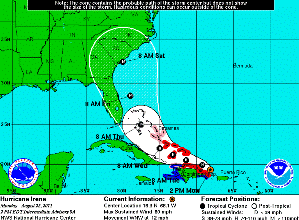Hurricane Irene forms in Atlantic, may hit Carolina polymer sites by weekend
By Ben DuBose
Online Editor Hurricane Irene formed early Monday near Puerto Rico, making it the first such storm of the 2011 Atlantic tropical season, according to the US National Hurricane Center (NHC).
Hurricane Irene formed early Monday near Puerto Rico, making it the first such storm of the 2011 Atlantic tropical season, according to the US National Hurricane Center (NHC).
Irene is expected to strike the southeastern US coast near South Carolina or North Carolina over the upcoming weekend as a major hurricane, with winds of at least 115 miles/hour.
The storm packed Category 1 winds of 80 miles/hour on Monday afternoon, but was forecast to soon strengthen to at least Category 3 status.
The two Carolina states comprise a crucial region for US plastics manufacturing. North Carolina is the seventh-largest plastics manufacturer for shipments and the eighth-largest state in plastics industry employment.
Among producers with significant regional production, DAK Americas has 550,000 tpy of terephthalic acid (PTA) capacity and 210,000 tpy of polyethylene terephthalate (PET) capacity in Cape Fear, North Carolina – located near the border of the two states.
Regional media reports said companies were closely monitoring the situation, but evacuations had not begun. Forecasters noted that with the storm’s likely landfall five days away, significant deviation in the projected track was possible.
Moreover, should Irene track slightly further west than expected, the east coast of Florida could still be in the storm’s crosshairs.
No major hurricane has made landfall in the US since 2005, when Katrina and Rita battered the coastlines of Louisiana, Texas and Mississippi. Those storms inflicted catastrophic damage and significantly lowered production rates from the heart of the US downstream industry.
In 2008, Hurricane Ike caused significant damage to facilities along the upper Texas coast, even though it was only a Category 2 storm. Ike’s peak winds of 100 miles/hour were below the 111 miles/hour threshold for a hurricane to be considered major.
Fortunately for industry, Irene is not forecast to move into the Gulf of Mexico, sparing the energy-intensive region (both onshore and offshore) from potential damage.
Follow Hydrocarbon Processing on Twitter for the latest in storm updates.






Comments